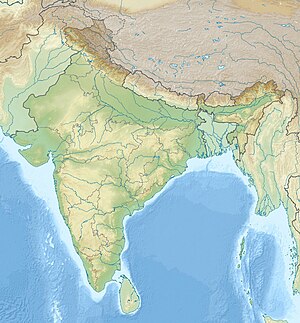Lower Subansiri Dam
| Lower Subansiri Dam Lower Subansiri Hydroelectric Power Project (LSHEP) |
|||||||
|---|---|---|---|---|---|---|---|
|
|||||||
|
|
|||||||
| Coordinates | 27 ° 32 '35 " N , 94 ° 15' 25" E | ||||||
| Data on the structure | |||||||
| Lock type: | Gravity dam | ||||||
| Construction time: | 2007-2018 (planned) [obsolete] | ||||||
| Height above valley floor: | 116 m | ||||||
| Height above foundation level : | 130 m | ||||||
| Building volume: | 2 250 000 m³ | ||||||
| Crown length: | 284 m | ||||||
| Power plant output: | 2 000 MW | ||||||
| Operator: | NHPC Limited | ||||||
| Data on the reservoir | |||||||
| Water surface | 33.5 km² | ||||||
| Reservoir length | 47 km | ||||||
| Storage space | 1370 million m³ | ||||||
| Design flood : | 37 500 m³ / s | ||||||
The Lower Subansari Dam, officially called Lower Subansiri Hydroelectric Power Project (LSHEP), is a dam project under construction with a gravity dam as a barrier structure on the Subansiri , a tributary of the Brahmaputra , in northeast India. The lock is located 2.3 km upstream of the village of Gerukamukh in the Lower Subansiri district in the Indian state of Arunachal Pradesh .
A run-of- river power plant is being built at the dam which, according to the client, NHPC Limited, will have a nominal output of 2000 MW. Measured in terms of electrical output, it is said to be the second largest hydropower plant in India after the Tehri Dam .
The project was scheduled for completion in 2018, but suffered some setbacks during construction from landslides, rescheduling and political resistance. Construction began in December 2007. It was interrupted in December 2011 due to the expected environmental pollution, but resumed in 2019.
Building
The concrete gravity dam is 116 m high above the river bed and 130 m above the foundation level . The dam will be 284 m long and have a structural volume of 2,250,000 m³. The reservoir has a storage capacity of 1.37 km³, of which 0.44 km³ can be used for power generation or irrigation. At normal water levels, the reservoir takes up an area of 33.5 km². The power house is on the left bank; it will receive eight 250 MW Francis turbines and generators. 7421 GWh of electricity are to be generated annually.
The flood relief has the shape of a ski jump.
In November 2011, the dam reached a height of 138 m, which is just below the overflow edge of the flood relief at 145 m (unclear due to contradiction in wall height, see info box). On December 16, 2011, the construction was interrupted by protests.
Drains
The water runoff below the dam will vary depending on the electricity demand and it is expected that there will be mostly low (6 m 3 / s) runoffs in winter and high runoffs of up to 2560 m 3 / s for electricity generation at peak times in the evening .
Environmental pollution
Above and below the site there will be environmental pollution that is typical of very large dams. This means, among other things, land loss and environmental damage.
The reservoir will flood a river section of 47 km in length and destroy 37.5 to 40 km² with subtropical Himalayan pine forests, subtropical Himalayan broadleaf forests, parts of the "Tale Valley Wildlife Sanctuary", an elephant biotope network and some fields.
Resettlement
According to official information, 38 families have to be relocated for the reservoir.
See also
- List of hydropower plants in India
- List of dams in the world (India)
- List of the largest dams on earth
- List of the largest reservoirs on earth
- List of the largest hydroelectric plants in the world
- Subansiri Dam
Individual evidence
- ^ A b Welcome to Subansiri (Lower) Project , NHPC India, accessed March 12, 2012
- ↑ Construction of Subansiri dam not to be stopped, TNN, Bennett, Coleman & Co. Ltd., Times of India, February 16, 2012, accessed March 9, 2012.
- ↑ Subansiri dam work not to be halted: Ramesh, The Assam Tribune, August 12, 2010, accessed August 28, 2010.
- ↑ T8N: KMSS Stages Statewide Protest Opposing Lower Subansiri Hydroelectric Project. In: Time8. June 17, 2019. Retrieved June 21, 2019 (American English).
- ↑ a b India: National Register of Large Dams 2009 ( Memento of the original of July 21, 2011 in the Internet Archive ) Info: The archive link has been inserted automatically and has not yet been checked. Please check the original and archive link according to the instructions and then remove this notice. , Central Water Commission, accessed July 10, 2011 (PDF file; 1.3 MB)
- ↑ Fighting India's mega dams , Tanmoy Sharma, China Dialogue, March 9, 2012, The Third Pole, accessed May 7, 2012
- ↑ People's Power Blocks Dam Construction in Northeast India , Peakwater, Tag Archive for 'Subansiri Dam', December 5, 2011, accessed May 7, 2012
- ↑ Lower Subansiri: NHPC had to pay Rs 3 B for forestland ( Memento of the original from March 4, 2016 in the Internet Archive ) Info: The archive link was inserted automatically and has not yet been checked. Please check the original and archive link according to the instructions and then remove this notice. , SANDRP, Dams, Rivers & People 2-issue 9-10-11, page 12, Oct, Nov, Dec 2004, accessed on March 9, 2012 (PDF file; 437 kB)
- ^ The Indigenous World 2004 , Diana Vinding, Eks-Skolens Trykkeri, ISSN 0105-4503 , ISBN 87-90730-83-6 , Copenhagen 2004, page 323, accessed on March 9, 2012
Web links
- Subansari (Lower) Project , accessed July 19, 2012
